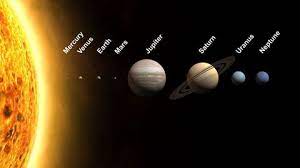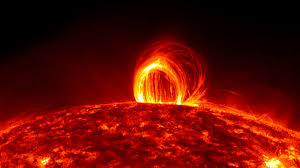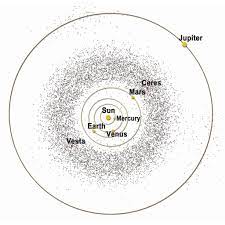The Solar System is a vast and complex system of celestial objects that orbit around a central star, the Sun. It is comprised of eight planets, several dwarf planets, numerous moons, asteroids, comets, and other small bodies. The Solar System is located in the Milky Way galaxy and is estimated to be around 4.6 billion years old.

Table of Contents
The Sun
The Sun is the star at the center of the Solar System and the source of life and energy for all living organisms on Earth. It is an extremely important celestial body that plays a crucial role in maintaining life on our planet.

The Sun is a massive ball of hot plasma that contains about 99.86% of the total mass in the Solar System, primarily composed of hydrogen and helium. It is so large that it could fit about 1.3 million Earths inside it. The Sun is approximately 4.6 billion years old and is expected to continue shining for another 5 billion years before it exhausts all its fuel and dies.
The Sun is the primary source of energy for all living organisms on Earth. The energy produced by the Sun is known as solar energy, which is harnessed by plants during photosynthesis to produce food. Humans also use solar energy in various forms, including solar panels that convert sunlight into electricity.
The Sun also plays a vital role in regulating Earth’s climate and weather patterns. The heat and light from the Sun drive atmospheric circulation, which influences wind patterns, ocean currents, and precipitation. The Sun’s energy also plays a crucial role in the water cycle, which is essential for life on Earth.
Despite its significance, the Sun can also pose a threat to life on Earth. Solar flares, which are explosions on the Sun’s surface, can release massive amounts of energy and particles that can affect our planet’s magnetic field and cause disruption to communication and navigation systems. Moreover, exposure to excessive amounts of ultraviolet radiation from the Sun can lead to skin cancer and other health problems.
Planets of Solar System
There are eight planets in the Solar System, and they are divided into two groups: the inner planets and the outer planets. The inner planets are Mercury, Venus, Earth, and Mars. They are also called the terrestrial planets because they are made of rock and have a solid surface. The outer planets are Jupiter, Saturn, Uranus, and Neptune. They are also called the gas giants because they are composed mainly of hydrogen and helium and have no solid surface.
Mercury
Mercury is the smallest planet in the Solar System, and it is also the closest planet to the Sun. It has a rocky surface, and it has no atmosphere. Mercury is also known for its extreme temperature variations, with temperatures reaching as high as 800 degrees Fahrenheit during the day and dropping to minus 290 degrees Fahrenheit at night.

Venus
Venus is the second planet from the Sun, and it is similar in size and composition to Earth. It has a thick atmosphere that is primarily composed of carbon dioxide, and it is also the hottest planet in the Solar System, with temperatures that can reach up to 900 degrees Fahrenheit. In fact it is the hottest planet of the solar system due to green house effect.

Earth
Earth is the third planet from the Sun, and it is the only planet in the Solar System that has life. It has a solid surface and a thin atmosphere that is rich in oxygen and nitrogen. Earth also has a strong magnetic field that protects it from harmful solar radiation.

Mars
Mars is the fourth planet from the Sun, and it is also known as the “Red Planet” because of its reddish appearance. It has a rocky surface, and it is also the planet in the Solar System that is most similar to Earth. Mars also has a thin atmosphere that is primarily composed of carbon dioxide.

Jupiter
Jupiter is the largest planet in the Solar System, and it is also one of the gas giants. It is primarily composed of hydrogen and helium, and it also has the most extensive planetary system in the Solar System, with 79 known moons.

Saturn
Saturn is the second-largest planet in the Solar System, and it is also a gas giant. It is known for its beautiful rings, which are made of ice particles and rock fragments. Saturn also has 82 known moons, including Titan, which is the largest moon in the Solar System.
Uranus
Uranus is the seventh planet from the Sun, and it is also a gas giant. It has a unique feature of being tilted at an angle of almost 98 degrees, which gives it its unusual appearance. Uranus also has 27 known moons.
Neptune
Neptune is the eighth planet from the Sun, and it is also a gas giant. It is primarily composed of hydrogen and helium, and it has 14 known moons. Neptune is also known for its strong winds, which can reach up to 1,500 miles per hour.
Moons in Solar System
In addition to the planets, the Solar System is also home to numerous moons. Most of the moons in the Solar System are located in orbit around the gas giants, and they come in a wide range of sizes and compositions. Some of the most well-known moons in the Solar System include Titan, which is the largest moon of Saturn, and Ganymede, which is the largest moon of Jupiter.
Asteroids
Asteroids are small, rocky objects that orbit the Sun, and they are often called minor planets. Most of the asteroids in the Solar System are located in the asteroid belt, which is located between Mars and Jupiter.

Comets
Comets are icy bodies that orbit the Sun, and they often have a tail that is visible from Earth. Comets are thought to be remnants from the early Solar System and are made up of ice, dust, and rock. Some of the most well-known comets in the Solar System include Halley’s Comet and Comet Hale-Bopp.
Kuiper Belt
The Kuiper Belt is a region of the Solar System located beyond Neptune’s orbit that is home to numerous small, icy objects, including dwarf planets and comets. Pluto was once considered the ninth planet in the Solar System but was reclassified as a dwarf planet in 2006 and is now considered a member of the Kuiper Belt.
Exoplanets
Exoplanets are planets that orbit stars outside of our Solar System. Since the first exoplanet was discovered in 1995, astronomers have discovered thousands of exoplanets using a variety of detection methods. Exoplanets come in a wide range of sizes and compositions, and some may even be habitable.
Formation of the Solar System
The System formed around 4.6 billion years ago from a giant cloud of gas and dust called a nebula. As the nebula collapsed, it formed a disk-like structure, with the Sun forming at the center and the planets forming from the leftover gas and dust in the disk. The process of planet formation is complex and involves gravity, collisions, and other forces.
Role of Gravity in Solar System
Gravity is a fundamental force in the Solar System and is responsible for keeping the planets in orbit around the Sun. Gravity also plays a role in the formation of the Solar System, as it causes the gas and dust in the disk to clump together and form larger objects.
Solar System : Questions
Q. Which planet is closest to the Sun?
a. Earth
b. Venus
c. Mercury
d. Mars
Answer: c. Mercury
Mercury is the closest planet to the Sun, and it is also the smallest planet in System. Its proximity to the Sun makes it one of the hottest planets, and it has a rocky surface with no atmosphere.
Q. Which planet is known for its unique tilted axis?
a. Saturn
b. Uranus
c. Jupiter
d. Neptune
Answer: b. Uranus
Uranus is known for its unique tilted axis, which is almost 98 degrees from its orbit around the Sun. This gives it a very unusual appearance, and it is the only planet in the Solar System that has this feature.
Q. Which planet has a rocky surface and no atmosphere?
a. Earth
b. Mars
c. Venus
d. Jupiter
Answer: b. Mars
Mars has a rocky surface and a thin atmosphere that is primarily composed of carbon dioxide. It is also known for its extreme temperature variations and has no liquid water on its surface.
Important Links